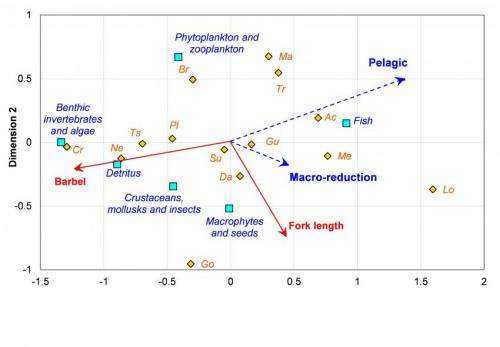The ecological niche concept is very important in ecology. But what a niche looks like is fairly abstract. Now, for the first time, Wageningen and British researchers have concretely visualised this. The ecologists have been able to determine the position of fourteen fish species in relationship to their food in a four-dimensional food diagram. Their pioneering work was published in this month's issue of the scientific journal Theoretical Ecology.
The ecological 'niche' concept was first used in 1927 by the well-known animal ecologist Joseph Grinnell. He defined the niche of an animal as its place in the biological environment and its interactions with food and enemies. The idea that the ecological role of animals is determined by their position in an abstract 'niche space' has since inspired many ecologists.
More than eighty years after Grinnell's formulation, Leo Nagelkerke of Wageningen University and Axel Rossberg of the Centre for Environment, Fisheries and Aquaculture Science (Cefas) in Lowestoft (UK) have made it possible to measure this niche space in concrete terms for a select group of fish species: the barbs in Lake Tana in Northern Ethiopia (see diagram).
The researchers determine the position in the diagram from the characteristics of both the fish and their food. The diagram shows that the fish species 'Cr' (Labeobarbus crassibarbis) is close to the food type 'benthic invertebrates (small bottom-dwelling animals) and algae'. The characteristic 'Barbel' (the length of the whiskers near the mouth) is highly developed in this fish species and previous research has, in fact, shown that barbels are important to eat this type of food. The food itself has a very low score on the characteristic 'Pelagic' (swimming in the water column), which is correct for bottom-dwellers.
Ecological niche
Visualising an ecological niche is an important step in bringing together theoretical and abstract ecology and observations from the field. Leo Nagelkerke from Wageningen University says that this method can help to identify and protect species that have a unique food niche. According to Axel Rossberg of Cefas a lot of ecologists have been working on the structure of the food niche and the position of species within it for a long time. "Using this new imaging technique we can answer questions of this kind via direct observations."
More information: Nagelkerke, L.A.J. & Rossberg, A.G. (2014) Trophic niche-space imaging, using resource and consumer traits. Theoretical Ecology. DOI: 10.1007/s12080-014-0229-5
Provided by Wageningen University





















